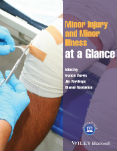-
1. What is the Glasgow coma score of the following patients?
(a) Eyes open to pain, withdrawal to pain, confused
(b) No eye opening, extending to pain, incomprehensible sounds
(c) Eyes open to voice, obeys commands, confused?
Show Answer
Correct answer:
(a) Eyes open to pain, withdrawal to pain, confused
GCS 10
(b) No eye opening, extending to pain, incomprehensible sounds
GCS 5
(c) Eyes open to voice, obeys commands, confused
GCS 13
See Chapter 7.
-
2. What are the indications for CT scan after head injury?
Show Answer
Correct answer:
- Amnesia of >30min pre-injury
- History of loss of consciousness and age >65 or dangerous mechanism of injury
- Reduced GCS
- New confusion
- Vomiting >1 in an adult, >3 times in a child
- Focal neurological signs
- Signs of basal skull fracture (panda eyes, bleeding from ears, cerebrospinal fluid from nose, bruising over mastoid process)
- Taking warfarin/other anticoagulant
See Chapter 7.
-
3. List the indications for referral for further assessment in an adult with non-traumatic transient loss of consciousness.
Show Answer
Correct answer:
- An ECG abnormality
- Heart failure
- Loss of consciousness on exertion
- Family history of sudden cardiac death in young
- An inherited cardiac condition
- >65 years with no prodromal symptoms
- New breathlessness
- A heart murmur
See Chapter 7.
-
4. Name five points to check in the general examination of a patient with neurological symptoms.
Show Answer
Correct answer:
- Do they look ill
- Vital signs, temperature
- Rash
- Neck stiffness
- Photophobia
See Chapter 8.
-
5. Name five points to check in examination of a patient’s eye with neurological symptoms.
Show Answer
Correct answer:
- Papillary reactions
- Visual acuity
- Visual fields
- Eye movements
- Examination of the fundus
See Chapter 8.
-
6. Name five points to check in examination of the head in a patient with neurological symptoms.
Show Answer
Correct answer:
- Tongue movements
- Facial movements
- Palate movement
- Hearing
- Tympanic membrane
See Chapter 8.
-
7. Name five points to check in the limbs in a patient with neurological symptoms.
Show Answer
Correct answer:
- Power
- Sensation
- Coordination
- Reflexes
- Gait and balance
See Chapter 8.
-
8. Name the peripheral nerves involved in a patient with the following deficits:
(a) Weakness of one side of the face, including forehead.
(b) Inability to extend wrist and fingers.
(c) Pain and paraesthesia in the thumb, index and middle fingers.
(d) Weakness of the small muscles of hand and paraesthesia in little finger.
(e) Unable to dorsiflex the foot.
Show Answer
Correct answer:
(a) Weakness of one side of the face, including forehead.
Facial nerve – Bell's palsy
(b) Inability to extend wrist and fingers.
Radial nerve palsy
(c) Pain and paraesthesia in the thumb, index and middle fingers.
Median nerve – carpal tunnel syndrome
(d) Weakness of the small muscles of hand and paraesthesia in little finger.
Ulnar nerve
(e) Unable to dorsiflex the foot.
Common peroneal nerve
See Chapter 8.
-
9. What are the red flag symptoms associated with a headache?
Show Answer
Correct answer:
- New onset or change in headache and age >50 years
- Sudden onset or thunderclap headache
- New focal neurological symptoms
- Change in cognition or personality
- Impaired consciousness
- Abnormal neurological examination
- Change in usual frequency and character of headache
- Headache affected by change in posture
- Headache affected by physical exertion, valsalva or cough
- Jaw claudication or visual disturbance in a patient age >50 years
- Neck stiffness
- Fever
- New-onset headache in a patient with a known history of cancer
- New-onset headache in a patient known to have HIV infection
See Chapter 9.

